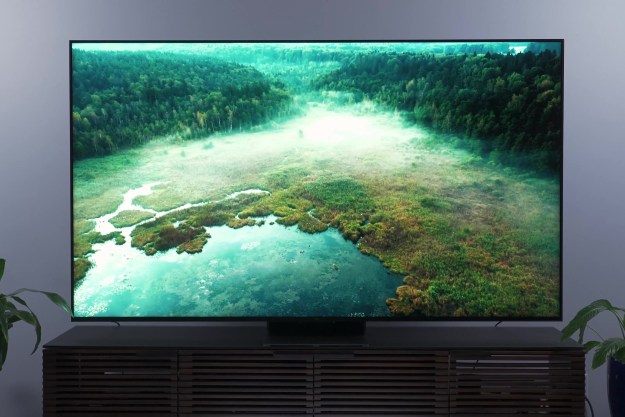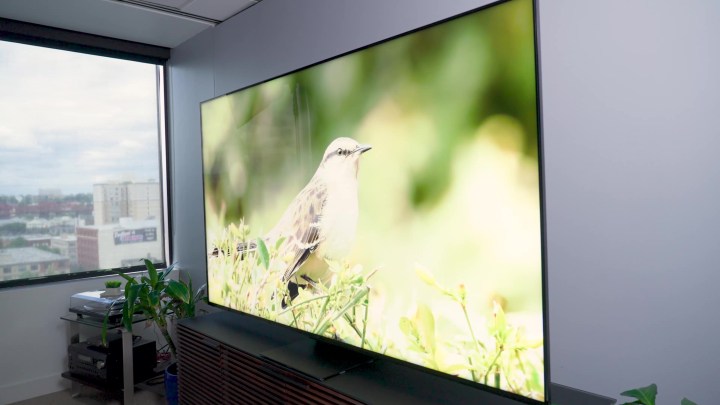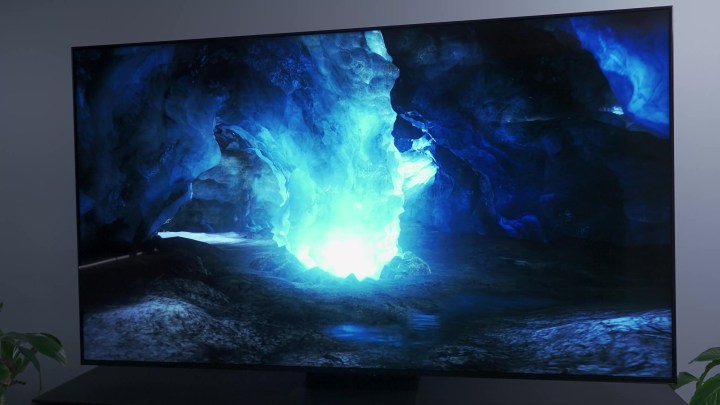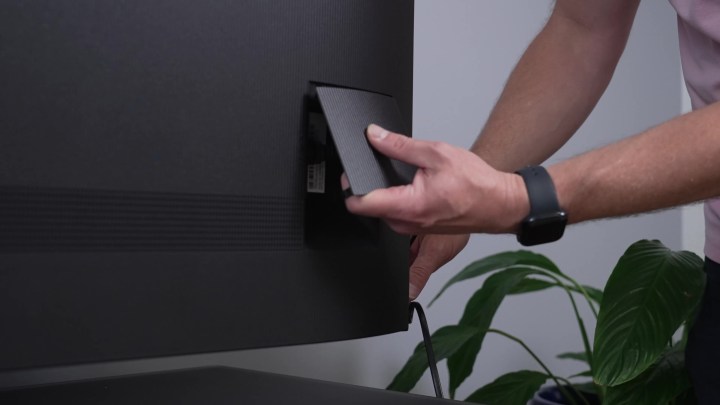
- Stunning HDR performance
- Class-leading brightness
- Excellent black levels
- Virtually no detectable blooming
- Very good color saturation/brightness
- Some motion artifacts
Already impressed by what the TCL QM8 looked like at CES 2023, I left TCL’s more recent launch party in New York gobsmacked by its performance, both visually and by the measurements I took on-site. I had an elevated opinion of this TV going into this review. But I also expected to find some flaws — every piece of tech hides some kind of shortcoming.
The TCL QM8 isn’t immune to that. But in the end? I think you’re going to like what I have to say about this TV.
Video review
Series and size details
While we reviewed the 85-inch (85QM850G) model, our review also applies to the 65-inch, 75-inch, and 98-inch models in the TCL QM8 Series.
| Screen Size | Model Number | MSRP |
| 65-inch | 65QM850G | $1,200 |
| 75-inch | 75QM850G | $1,700 |
| 85-inch | 85QM850G | $2,200 |
| 98-inch | 98QM850G | $10,000 |
Out of the box
If you’re interested in my full unboxing and setup experience, please check out our video above, if for no other reason than to laugh at me make an idiotic, totally avoidable, and almost-catastrophic mistake.
The key takeaways from that video are that I am not in love with the plastic portion of this TV’s pedestal stand, nor do I feel like the plastic cover panels on the back of the TV are of particularly high quality. But, ultimately, the stand is doing its job, and I’m in love with the fact that it is a pedestal-style stand as opposed to feet, as I think it gives the TV a better look and will help it fit on a wider variety of media stands.
Otherwise, I think the TV’s design is just fine, thank you very much.
Google TV is running like a dream on this TV, I’m happy to report — no laggy operation or crashing apps. The user menu has been a pleasure to work with as I’ve tested various settings and dialed this TV in.
I had the 85-inch TV to review, and it was a thrill to evaluate a TV of this size. My only regret is that if I use this unit in comparison to other TVs going forward, it’s going to dwarf the competing TVs, which are all 65-inch models.
Otherwise, for the most part, you can expect the other QM8 sizes — the 65-, 75-, and even the massive 98-inch versions — to perform similarly. The biggest difference as you move up in screen size will be seen in how much this TV lights up your room, because the more screen area you have pumping out light, the more light is going to be coming at you. It’s the same as if you had eight 60-watt lightbulbs, then stepped up to 12 bulbs, then to 18, and so on. Each bulb is putting out the same amount of light, but the more bulbs you have, the more lit up the room gets? That notion is going to be relevant here because this is one of the brightest TVs you can buy right now.
Brightness and color
Reviewers like me often talk about peak brightness as if it is the Holy Grail of TV performance benchmarks. It isn’t, necessarily — but the reason we do like to talk about peak brightness is that when watching HDR content, we want those HDR highlights to really gleam and sparkle, and having high brightness capabilities aids with that. But, also, if you watch TV in a fairly bright room, a brighter TV with a higher average picture level (APL) can still look vivid, even with lots of ambient light around. That is, most of the time. That’s another bit of foreshadowing. Lots of foreshadowing going on here.
With that preface out of the way, let’s dive into the measurements. I’m glad I measured this TV again rather than just relying on the measurements I got when I tested this model at TCL’s event in New York because I did learn some new things, and the unit I received does behave a little differently than that TV did.

Here’s the deal: I selected movie mode and touched nothing to see what customers will get if they buy this TV and just pick movie mode, which is the setting I’d recommend.
In SDR — with brightness set at 33 (out of 100) SDR brightness averaged just over 800 nits. That, my friends, is some very juiced-up SDR brightness. If you are a purist, you’re going to want to turn this TV’s brightness setting down, which sounds crazy considering it starts at 33 out of 100 and can go even brighter. But if you’re in a dark room, the default SDR movie setting could be a bit bright for you. Please adjust to taste.
In HDR, I got some insane readings.
Now, the grayscale — again, without calibration — was a bit heavy on the red and the blue. The average Delta E was around 6, which is technically within visible error territory for a well-trained eye, but not bad. More importantly, the average error was below two — that’s extremely good. And I can tell you that uncalibrated, this TV never looked way out of balance. And that goes for color, too, which had a Max Delta E of about 5.5 in SDR and HDR, but that’s because of a couple of bad apple colors — most of the colors were very accurate, lending to an average Delta E of 1.8 — this explains why I saw no red flags as I casually watched this TV.
In HDR, I got some insane readings. First, a disclaimer. I currently use a SpectraCal C6 profiled to an X-Rite i1 Pro 2. That C6 colorimeter is only rated to read up to 2,000 nits accurately, though I have seen it reading 2,500 nits and have good reason to trust it, as I’ve tested it against some more expensive meters in the past. Anything above 2500? Well, I can’t trust it for calibration, but — look, I’ll just come right out and say it — I got readings of up to 3,500 nits. Now, that was in Calman’s “Peak vs. Window Size” test, and maybe something funky happened there. But I ran it multiple times and that’s what I got. You can see the results below.

When I switched to the “Peak Luminance Stability” test in the Calman software, which allows me to set any size test window I want, the results consistently came in at around 2,500 nits, which is much closer to what TCL told me to expect from the QM8. Look, all I am saying is that this TV is more powerful than I can measure right now, and it is possible I’ve got an extra powerful one, to boot. I’m sure we’ll see some interesting readings from other reviewers with much more expensive meters than I currently own — that’s changing soon, by the way — but I think we can safely say this TV is extremely powerful. And we’ll talk about how it handles that power in a moment.
The QM8 covers 97% of DCI-P3 and about 76% of BT.2020, according to my readings. The HDR color accuracy again averaged a Delta E of just shy of 6 without calibration. So, technically not super accurate, but not way, way off either.
Most important is that a professional calibrator should be able to get this TV super accurate if you want. And with all the money you’ll save over more expensive TVs, I think it is well worth it if you want to go that route.
Black levels and contrast
Now, let’s step away from the measurements. We’ve established this TV can get extremely bright. But how is it with black levels and contrast? How’s the backlight system on this TV?
If you watch a lot of content like this where there’s bright, colorful stuff on dark backgrounds, you’ll swear this TV is practically as good as OLED.
Well, I’m pleased to report it is extremely impressive. When you sit on-axis with this TV — more or less right in front of it — blooming or halo effect is a nonissue. Depending on your vision, you may see a corona of light around bright objects on a dark background, but you are not likely to see blooming on this TV. Even when you step off well to the side, where you can typically see blooming very easily on even the best TVs, it’s very minimal. TCL has done an outstanding job breaking the mini-LEDs into the right amount of zones to get high brightness and great black levels out of this set. Go ahead and turn on the closed captions — you will not be bothered by this halo of light popping up in the letterbox bars. If you watch a lot of content like this where there’s bright, colorful stuff on dark backgrounds, you’ll swear this TV is practically as good as OLED.
But it is not as good as OLED is in the black level department. Even though it can make big dark areas very dark, it doesn’t have pixel-level dimming. So, say you’ve got a gray tweed jacket where some of the fibers are black, and others right next to them are light gray. On an OLED, those black fibers will be jet black, sitting right next to the light gray. And that kind of contrast, which gives some real 3-dimensional reality to textures, can’t quite be pulled off by any LED-backlit LCD TV. But, wow, does the QM8 ever get close! The contrast on this TV is just out-of-this-world impressive, partially because it can get so bright, yes, but also because its blacks are remarkably good.
There is one little caveat, though, and that is that this TV does crush blacks a little bit. That’s the trade-off. We could get a little more shadow detail, sure, but that would end up being at the expense of the inky blacks we’re getting here. I suspect that for most people most of the time, the small sacrifice to shadow detail is going to be worth it.

The exception is when you’re watching really dark shows. Series like Silo, Ozark, or Game of Thrones, for example, are all created by folks who are in the business of making their content look the way they see it in their head, not the way they see it in your living room. They do not shy away from making dark content. That dark content is watchable on this and many other TVs, but it is best watched in a very dark room. Do not expect to watch these shows using the Dolby Vision Dark picture preset with the lights turned on. The Dolby Vision Bright picture mode with the lights on is a watchable scenario, but really, I suggest watching dark shows in
Color on the QM8, as I stated earlier, is very good and can be excellent when calibrated. I have no complaints about the color on this set, even without calibration — it’s very good when you use the TV’s Movie picture mode. That is, so long as you sit on-axis. If you sit well off to the side of this TV, a fair bit of the color saturation drops off, which means folks sitting on the far end of a sectional couch won’t be getting an experience quite as good as those sitting directly in front of the TV. Like most LCD TVs that use a VA panel (which is most of them), there is a sweet spot to be enjoyed.
Motion
Motion is one of the areas in which this TV doesn’t perform quite as well as some others, though I do have to point out that those “others,” like the Sony X93L, for instance, may have better motion resolution, but also cost twice as much.
The motion issues I detected come mostly with 24 frames-per-second (fps) content — so movies and high-quality shows like Silo and Ozark and any number of streaming TV shows that are shot like movies as opposed to “TV.”

In an absolute torture test, you’ll see a fair amount of judder going on. Now, you can get rid of it entirely or just tamp down on it using the de-judder option in the motion portion of the TV’s menu, but the more you use, the more fake the image is going to look.
By comparison, the X93L is significantly smoother — Sony’s processing is really, really good. So, this is one area where you can get better performance from a more expensive TV. But at almost double the price, is that something you’ll worry about?
Tone mapping
Now, on to tone mapping — that’s how the TV handles the incoming brightness range signal and then adapts it to work with its capabilities, which in many cases will exceed that of the input signal. Most content is mastered at 1,000 nits, and this TV can get twice that bright. I think the TV does a great job — with Dynamic Tone Mapping turned off — at maintaining highlight detail in the brightest areas. It doesn’t just over-brighten stuff and clip it off prematurely. As mentioned, the dark areas can get a little crushed, but at least it isn’t raising blacks to the point they look gray or milky.
Picture quality overview
Now, let me step away from the deep TV enthusiast picture performance stuff for a moment and just let me say that I think the QM8 looks fantastic. I’ve enjoyed watching this TV a ton, and I would 100% put this TV in my own living room. In fact, I probably will. If I don’t get shocked by one of the TVs coming down the pike, I will probably make this TV my daily driver at home. I’ll explain why in just a moment when I put this all into perspective at the end. But first, we have to talk about gaming.
Gaming
Now, as I’ve said before, I am not a hardcore gamer. I can look at a TV from a metrics perspective and extrapolate a lot from that. I can also play Forza, PGA Tour, and any number of other beautiful games that I enjoy playing but am arguably terrible at. They looked and felt great to me on this TV. But, unlike my picture-quality evaluations, of which I am quite confident, I have not gotten my gaming chops up to a level where I am comfortable speaking to gaming enthusiasts and saying, “My take is gold, so take my word for it.” I just won’t do that.

What I can tell you is that this TV will go up to 4K resolution at 144Hz. I can say that it supports VRR, and I have not seen any horrible screen tearing – in fact, at higher refresh rates, this TV looks super clean and crisp. I also haven’t noticed any nasty backlight anomalies when in VRR mode — the picture stays looking great. I can also say that the black frame insertion (BFI) is flickery and I won’t use it, but I say that about every TV.
Beyond that, I’m not going to get into the gaming weeds. I’ll leave that to the gaming experts and, in the meantime, try to spend more of my scant amount of free time gaming.
The only QLED you need?
Here’s where I land with the TCL QM8: It will be my go-to TV recommendation for probably 90% of people this year. It is just that good for the price. It is super hard for me to justify recommending competing TVs when they cost almost twice as much. TCL has closed the performance gap to such a high degree that the price gap is hard to justify. I mean, yeah, OLED is still king. But a 65-inch TCL QM8 for as low as $1,200 versus, say, an LG C3 OLED for $2,200? Really makes you think, doesn’t it? The number of folks who are going to value the difference that an LG C3 or G3 or a Samsung S90C or Sony A80J offer in terms of picture quality enough to justify that additional cost is shrinking rapidly.
That’s why the TCL QM8 is such a massive winner for me. It’s going to thrill an extremely broad audience. This TV needs to be on everyone’s shortlist. And I do mean everyone.
Editors' Recommendations
- Sony debuts the Bravia 9, its brightest 4K TV ever, alongside new 2024 models
- TCL’s bonkers China-only microLED TV is as tall as Darth Vader
- TCL’s giant 115-inch QM89 is the world’s largest 4K mini-LED TV
- Mini-LED vs. QLED TV: how one technology is improving the other
- Hisense just debuted the world’s largest mini-LED TV at 100 inches









